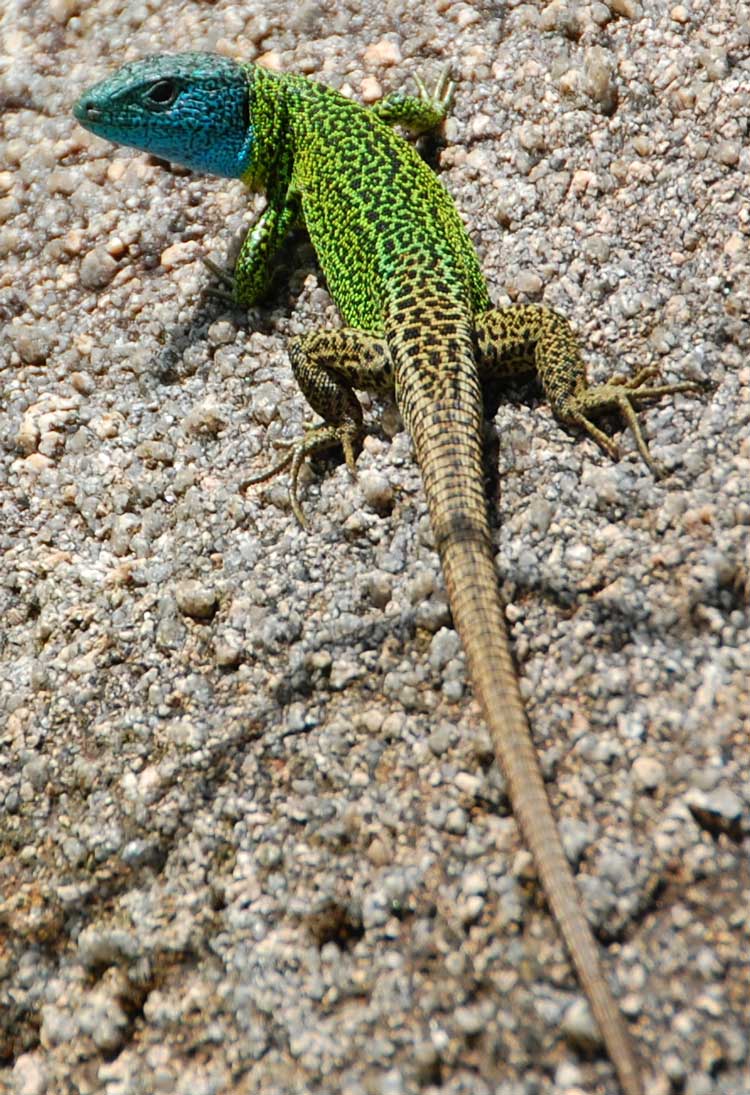
Lacerta schreiberi (*)
Superregnum: Eukaryota
Cladus: Unikonta
Cladus: Opisthokonta
Cladus: Holozoa
Regnum: Animalia
Subregnum: Eumetazoa
Cladus: Bilateria
Cladus: Nephrozoa
Superphylum: Deuterostomia
Phylum: Chordata
Subphylum: Vertebrata
Infraphylum: Gnathostomata
Megaclassis: Osteichthyes
Cladus: Sarcopterygii
Cladus: Rhipidistia
Cladus: Tetrapodomorpha
Cladus: Eotetrapodiformes
Cladus: Elpistostegalia
Superclassis: Tetrapoda
Cladus: Reptiliomorpha
Cladus: Amniota
Classis: Reptilia
Cladus: Eureptilia
Cladus: Romeriida
Subclassis: Diapsida
Cladus: Sauria
Infraclassis: Lepidosauromorpha
Superordo: Lepidosauria
Ordo: Squamata
Cladus: Unidentata Episquamata
Subordo: Lacertoidea
Infraordo: Lacertibaenia
Familia: Lacertidae
Subfamilia: Lacertinae
Genus: Lacerta
Species: Lacerta schreiberi
Name
Lacerta schreiberi Bedriaga, 1878
Vernacular names
español: Lagarto verdinegro
euskara: Schreiber muskerra
galego: Lagarto das silvas
português: Lagarto-de-água
The Iberian emerald lizard (Lacerta schreiberi), also known commonly as Schreiber's green lizard, is a species of lizard in the family Lacertidae. The species is endemic to the Iberian Peninsula.[1]
Etymology
Male lizard
The specific name, schreiberi, is in honor of Austrian zoologist Egid Schreiber (1836–1913), author of Herpetologia Europaea (1875).[2]
It is known as Lagarto-de-água (water lizard) in Portuguese and lagarto verdinegro (green and black lizard) in Spanish.
Geographic range
Iberian emerald lizard in Peneda-Gerês National Park
Lacerta schreiberi is found in Portugal and Spain.
Habitat
Juvenile
The natural habitats of L. schreiberi are temperate forests and shrublands, Mediterranean-type shrubby vegetation, rivers, and pastureland.
Conservation status
Lacerta schreiberi is threatened by habitat loss.
Description
A large species, L. schreiberi measures about 13.5 cm (5.3 in) snout-to-vent (SVL); including the tail, it measures about 38 cm (15 in).
Diet
Lacerta schreiberi is mainly insectivorous, though it also preys on small lizards like the iberian wall lizard or large psammodromus.[3]
Reproduction
Lacerta schreiberi is oviparous.[4] Clutch size varies from 11 to 28 eggs.[3]
References
Paulo Sá-Sousa, Rafael Marquez, Valentin Pérez-Mellado, Iñigo Martínez-Solano (2009). "Lacerta schreiberi". IUCN Red List of Threatened Species. 2009: e.T11113A3251580. doi:10.2305/IUCN.UK.2009.RLTS.T11113A3251580.en. Retrieved 15 November 2021.
Beolens, Bo; Watkins, Michael; Grayson, Michael (2011). The Eponym Dictionary of Reptiles. Baltimore: Johns Hopkins University Press. xiii + 296 pp. ISBN 978-1-4214-0135-5. (Lacerta schreiberi, p. 238).
"Lacerta schreiberi . pp. 156-157. In: Catálogo Regional de Especies Amenazadas by Juan Pablo Prieto Clemente" (PDF). Archived from the original (PDF) on 2009-12-19. Retrieved 2013-11-26. (in Spanish).
Species Lacerta schreiberi at The Reptile Database www.reptile-database.org.
Further reading
Arnold EN, Burton JA (1978). A Field Guide to Reptiles and Amphibians of Britain and Europe. London: Collins. 272 pp. + Plates 1-40. ISBN 0-00-219318-3. (Lacerta schreiberi, p. 131 + Plate 20, figures 2a & 2b; Plate 22, figure 2 + Map 66).
Bedriaga J (1878). "Herpetologische Studien ". Archiv für Naturgeschichte 44 (1): 259–320. (Lacerta schreiberi, new species, pp. 299–303 + Plate X, figures 3 & 4). (in German and Latin).
Retrieved from "http://en.wikipedia.org/"
All text is available under the terms of the GNU Free Documentation License

